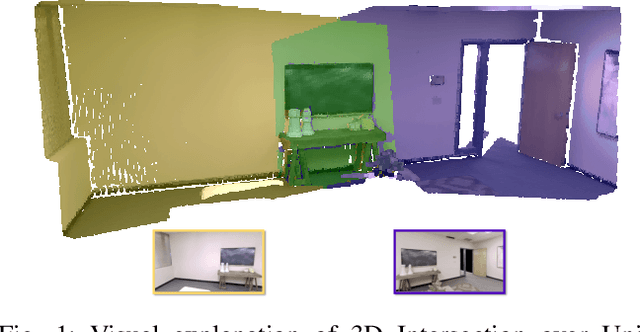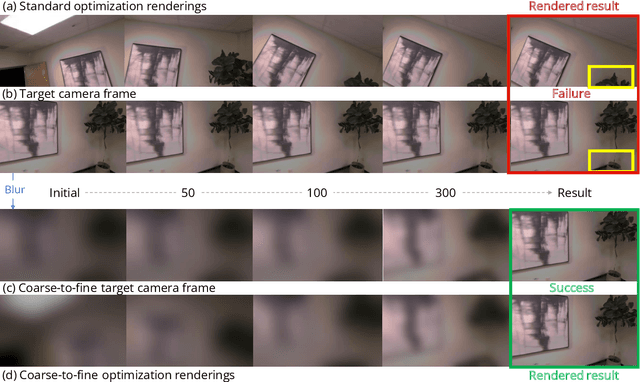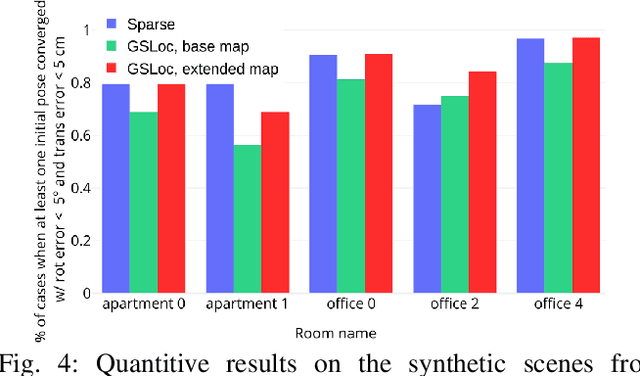Gonzalo Ferrer
Good Keypoints for the Two-View Geometry Estimation Problem
Mar 24, 2025Abstract:Local features are essential to many modern downstream applications. Therefore, it is of interest to determine the properties of local features that contribute to the downstream performance for a better design of feature detectors and descriptors. In our work, we propose a new theoretical model for scoring feature points (keypoints) in the context of the two-view geometry estimation problem. The model determines two properties that a good keypoint for solving the homography estimation problem should have: be repeatable and have a small expected measurement error. This result provides key insights into why maximizing the number of correspondences doesn't always lead to better homography estimation accuracy. We use the developed model to design a method that detects keypoints that benefit the homography estimation introducing the Bounded NeSS-ST (BoNeSS-ST) keypoint detector. The novelty of BoNeSS-ST comes from strong theoretical foundations, a more accurate keypoint scoring due to subpixel refinement and a cost designed for superior robustness to low saliency keypoints. As a result, BoNeSS-ST outperforms prior self-supervised local feature detectors in both planar homography and epipolar geometry estimation problems.
GSLoc: Visual Localization with 3D Gaussian Splatting
Oct 08, 2024



Abstract:We present GSLoc: a new visual localization method that performs dense camera alignment using 3D Gaussian Splatting as a map representation of the scene. GSLoc backpropagates pose gradients over the rendering pipeline to align the rendered and target images, while it adopts a coarse-to-fine strategy by utilizing blurring kernels to mitigate the non-convexity of the problem and improve the convergence. The results show that our approach succeeds at visual localization in challenging conditions of relatively small overlap between initial and target frames inside textureless environments when state-of-the-art neural sparse methods provide inferior results. Using the byproduct of realistic rendering from the 3DGS map representation, we show how to enhance localization results by mixing a set of observed and virtual reference keyframes when solving the image retrieval problem. We evaluate our method both on synthetic and real-world data, discussing its advantages and application potential.
Visual place recognition for aerial imagery: A survey
Jun 02, 2024Abstract:Aerial imagery and its direct application to visual localization is an essential problem for many Robotics and Computer Vision tasks. While Global Navigation Satellite Systems (GNSS) are the standard default solution for solving the aerial localization problem, it is subject to a number of limitations, such as, signal instability or solution unreliability that make this option not so desirable. Consequently, visual geolocalization is emerging as a viable alternative. However, adapting Visual Place Recognition (VPR) task to aerial imagery presents significant challenges, including weather variations and repetitive patterns. Current VPR reviews largely neglect the specific context of aerial data. This paper introduces a methodology tailored for evaluating VPR techniques specifically in the domain of aerial imagery, providing a comprehensive assessment of various methods and their performance. However, we not only compare various VPR methods, but also demonstrate the importance of selecting appropriate zoom and overlap levels when constructing map tiles to achieve maximum efficiency of VPR algorithms in the case of aerial imagery. The code is available on our GitHub repository -- https://github.com/prime-slam/aero-vloc.
Mapping the Unseen: Unified Promptable Panoptic Mapping with Dynamic Labeling using Foundation Models
May 03, 2024Abstract:In the field of robotics and computer vision, efficient and accurate semantic mapping remains a significant challenge due to the growing demand for intelligent machines that can comprehend and interact with complex environments. Conventional panoptic mapping methods, however, are limited by predefined semantic classes, thus making them ineffective for handling novel or unforeseen objects. In response to this limitation, we introduce the Unified Promptable Panoptic Mapping (UPPM) method. UPPM utilizes recent advances in foundation models to enable real-time, on-demand label generation using natural language prompts. By incorporating a dynamic labeling strategy into traditional panoptic mapping techniques, UPPM provides significant improvements in adaptability and versatility while maintaining high performance levels in map reconstruction. We demonstrate our approach on real-world and simulated datasets. Results show that UPPM can accurately reconstruct scenes and segment objects while generating rich semantic labels through natural language interactions. A series of ablation experiments validated the advantages of foundation model-based labeling over fixed label sets.
Shi-NeSS: Detecting Good and Stable Keypoints with a Neural Stability Score
Jul 03, 2023Abstract:Learning a feature point detector presents a challenge both due to the ambiguity of the definition of a keypoint and correspondingly the need for a specially prepared ground truth labels for such points. In our work, we address both of these issues by utilizing a combination of a hand-crafted Shi detector and a neural network. We build on the principled and localized keypoints provided by the Shi detector and perform their selection using the keypoint stability score regressed by the neural network - Neural Stability Score (NeSS). Therefore, our method is named Shi-NeSS since it combines the Shi detector and the properties of the keypoint stability score, and it only requires for training sets of images without dataset pre-labeling or the need for reconstructed correspondence labels. We evaluate Shi-NeSS on HPatches, ScanNet, MegaDepth and IMC-PT, demonstrating state-of-the-art performance and good generalization on downstream tasks.
Social Robot Navigation through Constrained Optimization: a Comparative Study of Uncertainty-based Objectives and Constraints
May 04, 2023Abstract:This work is dedicated to the study of how uncertainty estimation of the human motion prediction can be embedded into constrained optimization techniques, such as Model Predictive Control (MPC) for the social robot navigation. We propose several cost objectives and constraint functions obtained from the uncertainty of predicting pedestrian positions and related to the probability of the collision that can be applied to the MPC, and all the different variants are compared in challenging scenes with multiple agents. The main question this paper tries to answer is: what are the most important uncertainty-based criteria for social MPC? For that, we evaluate the proposed approaches with several social navigation metrics in an extensive set of scenarios of different complexity in reproducible synthetic environments. The main outcome of our study is a foundation for a practical guide on when and how to use uncertainty-aware approaches for social robot navigation in practice and what are the most effective criteria.
TT-SDF2PC: Registration of Point Cloud and Compressed SDF Directly in the Memory-Efficient Tensor Train Domain
Apr 11, 2023



Abstract:This paper addresses the following research question: ``can one compress a detailed 3D representation and use it directly for point cloud registration?''. Map compression of the scene can be achieved by the tensor train (TT) decomposition of the signed distance function (SDF) representation. It regulates the amount of data reduced by the so-called TT-ranks. Using this representation we have proposed an algorithm, the TT-SDF2PC, that is capable of directly registering a PC to the compressed SDF by making use of efficient calculations of its derivatives in the TT domain, saving computations and memory. We compare TT-SDF2PC with SOTA local and global registration methods in a synthetic dataset and a real dataset and show on par performance while requiring significantly less resources.
Eigen-Factors an Alternating Optimization for Back-end Plane SLAM of 3D Point Clouds
Apr 03, 2023Abstract:Modern depth sensors can generate a huge number of 3D points in few seconds to be latter processed by Localization and Mapping algorithms. Ideally, these algorithms should handle efficiently large sizes of Point Clouds under the assumption that using more points implies more information available. The Eigen Factors (EF) is a new algorithm that solves SLAM by using planes as the main geometric primitive. To do so, EF exhaustively calculates the error of all points at complexity $O(1)$, thanks to the {\em Summation matrix} $S$ of homogeneous points. The solution of EF is highly efficient: i) the state variables are only the sensor poses -- trajectory, while the plane parameters are estimated previously in closed from and ii) EF alternating optimization uses a Newton-Raphson method by a direct analytical calculation of the gradient and the Hessian, which turns out to be a block diagonal matrix. Since we require to differentiate over eigenvalues and matrix elements, we have developed an intuitive methodology to calculate partial derivatives in the manifold of rigid body transformations $SE(3)$, which could be applied to unrelated problems that require analytical derivatives of certain complexity. We evaluate EF and other state-of-the-art plane SLAM back-end algorithms in a synthetic environment. The evaluation is extended to ICL dataset (RGBD) and LiDAR KITTI dataset. Code is publicly available at https://github.com/prime-slam/EF-plane-SLAM.
EVOLIN Benchmark: Evaluation of Line Detection and Association
Mar 09, 2023



Abstract:Lines are interesting geometrical features commonly seen in indoor and urban environments. There is missing a complete benchmark where one can evaluate lines from a sequential stream of images in all its stages: Line detection, Line Association and Pose error. To do so, we present a complete and exhaustive benchmark for visual lines in a SLAM front-end, both for RGB and RGBD, by providing a plethora of complementary metrics. We have also labelled data from well-known SLAM datasets in order to have all in one poses and accurately annotated lines. In particular, we have evaluated 17 line detection algorithms, 5 line associations methods and the resultant pose error for aligning a pair of frames with several combinations of detector-association. We have packaged all methods and evaluations metrics and made them publicly available on web-page https://prime-slam.github.io/evolin/.
Dominating Set Database Selection for Visual Place Recognition
Mar 09, 2023Abstract:This paper presents an approach for creating a visual place recognition (VPR) database for localization in indoor environments from RGBD scanning sequences. The proposed approach is formulated as a minimization problem in terms of dominating set algorithm for graph, constructed from spatial information, and referred as DominatingSet. Our algorithm shows better scene coverage in comparison to other methodologies that are used for database creation. Also, we demonstrate that using DominatingSet, a database size could be up to 250-1400 times smaller than the original scanning sequence while maintaining a recall rate of more than 80% on testing sequences. We evaluated our algorithm on 7-scenes and BundleFusion datasets and an additionally recorded sequence in a highly repetitive office setting. In addition, the database selection can produce weakly-supervised labels for fine-tuning neural place recognition algorithms to particular settings, improving even more their accuracy. The paper also presents a fully automated pipeline for VPR database creation from RGBD scanning sequences, as well as a set of metrics for VPR database evaluation. The code and released data are available on our web-page~ -- https://prime-slam.github.io/place-recognition-db/
 Add to Chrome
Add to Chrome Add to Firefox
Add to Firefox Add to Edge
Add to Edge